Stanphyl Capital commentary for the month ended June 30, 2025.
Friends and Fellow Investors:
For June 2025 the fund was up approximately 9.6% net of all fees and expenses. By way of comparison, the S&P 500 was up 5.1% and the Russell 2000 was up 5.4%. Year-to-date the fund is up approximately 20.6% while the S&P 500 is up 6.2% and the Russell 2000 is down 1.8%. Since inception on June 1, 2011 the fund is up approximately 50.4% net while the S&P 500 is up 501.5% and the Russell 2000 is up 211.3%. Since inception the fund has compounded at approximately 2.9% net annually vs. 13.6% for the S&P 500 and 8.4% for the Russell 2000. (The S&P and Russell performances are based on their “Total Returns” indices which include reinvested dividends. Investors will receive exact performance figures from the outside administrator within a week or two. Please note that individual partners’ returns will vary in accordance with their high-water marks.)
We were up this month despite being short SPY with the S&P 500 at a new high because we had good gains on our Tesla short and on a long position in a tiny company I hadn’t mentioned in these letters. (The latter gains—in FTEK—have now been “realized” and we no longer hold the position.)
Stocks remain extremely expensive with the S&P 500 selling for around 25x estimated Q2 annualized operating earnings (more on that below), and other popular metrics show similar overvaluation:
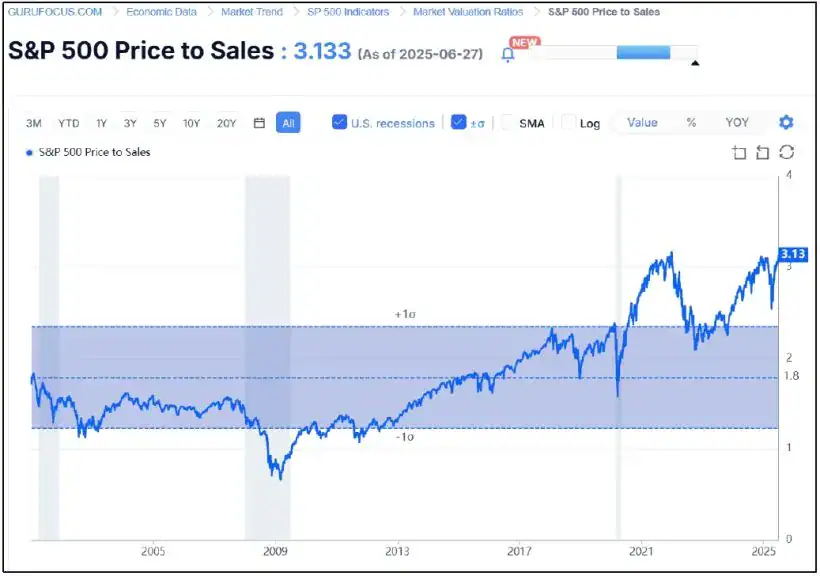
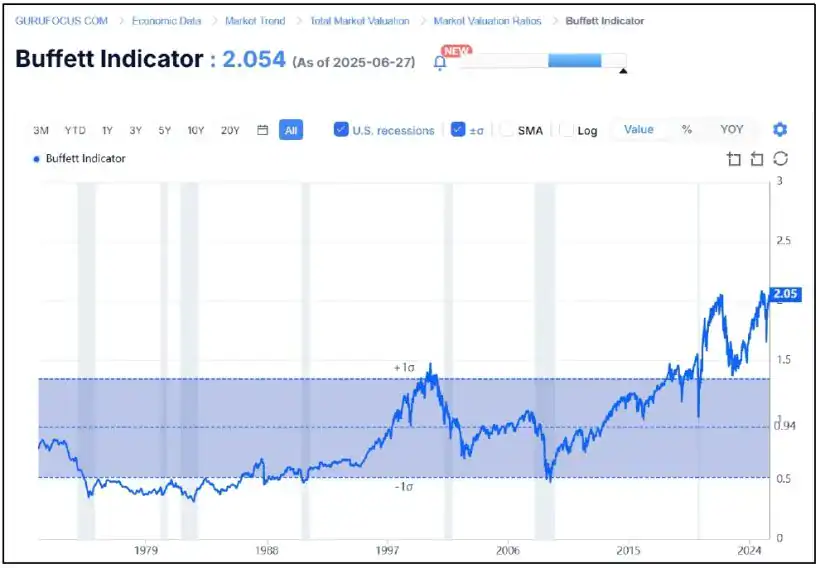
…and even “not as bad as Trump threatened” tariffs (best case: 10% on some things and 25% on others) will force almost every U.S. company into a more expensive supply chain, thus making profit margins for already expensive stocks significantly worse:
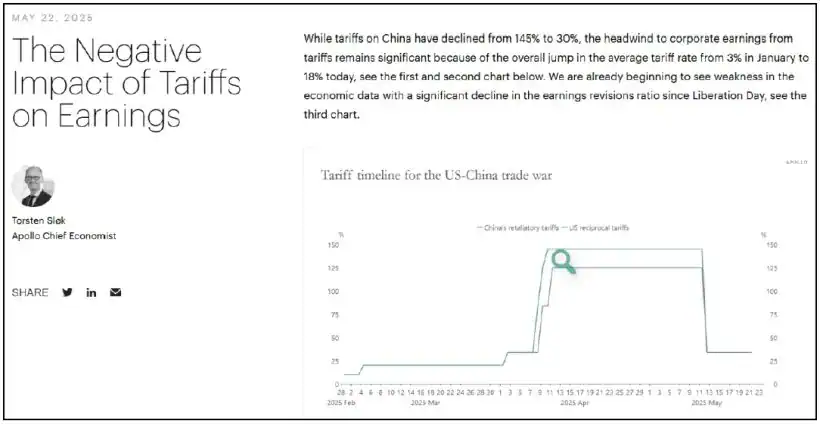
And meanwhile the U.S. economy is clearly slowing, as it’s increasingly hard to find a job and freight activity continues to slide:

We thus remain short the S&P 500 (via the SPY ETF). According to Standard & Poor’s, Q2 2025 S&P 500 operating earnings will be around $62.22 (their most recent estimate dated June 17, and those estimates almost always turn out to be too high), which is $248.88 annualized. The S&P 500 is currently selling for around 25x those annualized run-rate operating earnings, yet the traditional “rule of 20” (which says that its PE ratio should be 20 minus the current 2.4% rate of CPI inflation) would put a 17.6x multiple on them, thus bringing that index down to just 4380 vs. the current 6205, a drop of nearly 30%.
And remember, that 2.4% year-over-year May inflation rate is mostly “pre-tariffs” (before they work their way into prices as Walmart warned they will) and is thus likely going much higher, thereby further compressing PE multiples. So, for example, a 3% tariff-induced inflation rate combined with 10% lower earnings would put a 17x multiple on $223.99 (the above-mentioned $248.88 less 10%) and create an S&P 500 target of just 3808. So stocks are at an extreme level of valuation while sticky inflation should prevent the Fed from significantly cutting rates, and if not…
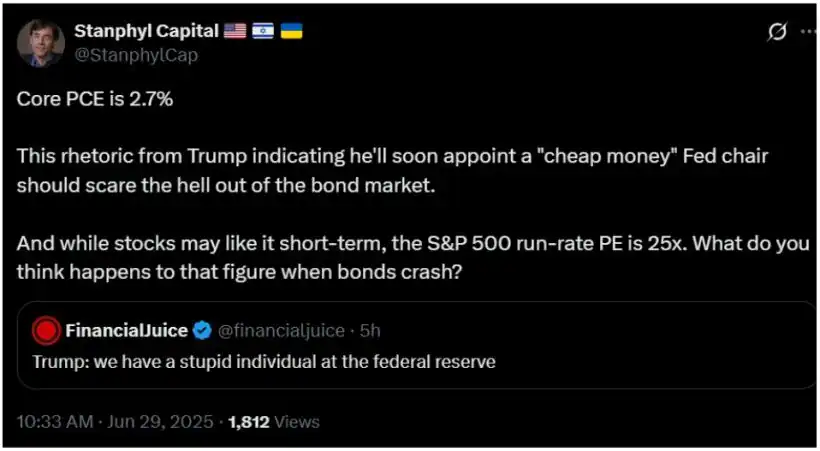
And here’s another bearish thought I had today:
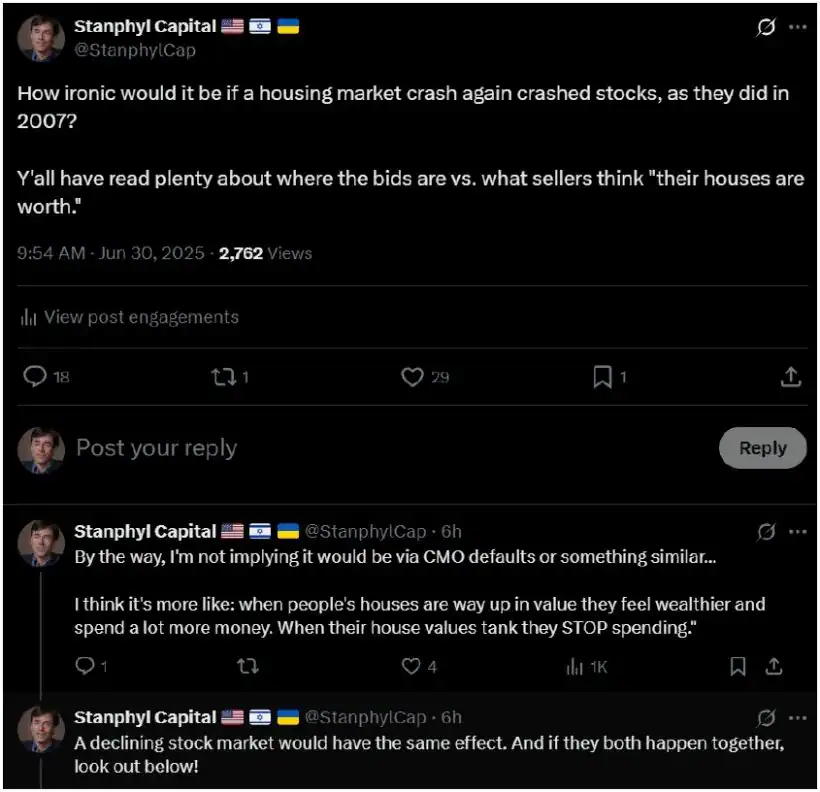
Meanwhile, we continue to be long Volkswagen AG (via its VWAPY ADR). Although Trump’s auto tariff is a definite negative, especially for Audi and Porsche which currently (before Audi possibly builds a U.S. plant) import 100% of their U.S. cars, CEO Oliver Blume is doing all the right things to position VW for the future, including a tough cost-cutting agreement with its union, a joint venture obtaining access to Rivian’s excellent EV software (here’s a good explanation of the rationale behind that) and JVs in China with Xpeng and SAIC, as well as one for AI driver assistance, and a U.S. robotaxi deal with Uber. VW currently sells for less than 5x its €18.91/share 2025 earnings estimate while controlling a massive number of terrific brands including separately listed Porsche, of which it owns 75% at a current market cap (for Porsche) of around €38 billion and Traton, of which it owns 87.5% at a current market cap (for Traton) of around €14 billion, thus making VW’s €29 billion Porsche stake and €12 billion Traton stake combined worth only around €4 billion less than the entire €45 billion market cap of VW. In other words, at current prices you’re only paying €4 billion to own all these brands:
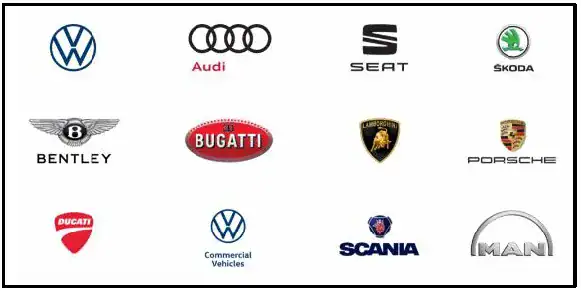
I believe that on a sum-of-the-parts analysis Volkswagen is worth around €140 billion, which would be nearly $30 per VWAPY ADR vs. June’s closing price of just $10.52. Additionally, the stock yields over 6%, and VW has a wide range of electric cars available and in development (including one for €20,000) as demand (or regulatory requirements) for them develops, as well as a slew of new models for China and even a battery energy storage business.
We remain short Tesla, which in July will report yet another horrible quarter, with sales, margins and profits again all down substantially from the year-ago quarter. even before the upcoming tax bill kills the U.S. $7500 consumer credit and the Trump administration rolls back the fleet CO2 emission requirements that generate the credit sales that are by far Tesla’s most profitable “product.” (And its energy credits and European emission credits are also disappearing.) In fact, things are so bad at Tesla that in June Musk fired his head of sales and manufacturing.
TSLA closed June at a price of $317.66/share, giving this declining-earnings & revenue car company (only 10% of its 2024 revenue came from energy storage which Trump’s China tariffs and subsidy- ending will destroy) a PE ratio of nearly 318(!) on my ballpark estimate of $1/share in 2025 non-GAAP earnings. Yet auto companies comparable to Tesla sell for only around 6x earnings, which would make its stock worth only around $6/share plus perhaps $8/share for its net cash (if it really exists).
No wonder Musk is trying to nonsensically claim that Tesla is “really a robot, robotaxi and AI company!” In fact, Tesla’s so-called “robotaxi” is nothing but a dangerous scam—much more on that below.
Meanwhile, Toyota and Waymo (which has a self-driving system infinitely superior to Tesla’s) announced a partnership to explore making Waymo’s system available in Toyota’s consumer vehicles. And in China Tesla’s competitors have better driver assistance systems, and in many case they’re being given away for free. Keep in mind that Musk has said multiple times that most of the value of Tesla is in the revenue it can generate from this system, and in China, at least, that may now be zero.
Regarding Tesla’s purported robot business, Apple and Meta as well as Amazon and Nvidia & Foxconn—all of which have vastly more resources than Tesla—will make humanoid robots, as are multiple companies in China, Hyundai and a company already being used by BMW), and in June the head of Tesla’s program suddenly left the company. Yet this is a product that Musk claimed (apparently with a straight face) Tesla’s domination of would make it more valuable than the next five companies in the world combined. (Sadly, the stock-dumping corporate insiders don’t seem to believe that.)
In 2019 Musk claimed that the hardware in then-current Teslas (and every subsequent Tesla) would soon receive software to make them hugely profitable "robotaxis.” As far back as January 2016 he claimed that every new Tesla had all the hardware needed to be completely self-driving and would receive the necessary software by 2018, and he “demonstrated” this with a completely fraudulent promotional video. Meanwhile, here we are in 2025 and Tesla’s “autonomy” system has been linked to hundreds of crashes and dozens of deaths, and in December 2024 the Head of Autopilot Hardware Engineering left the company, lawsuits against this product continue to pile up, and it may be a basis for millions of people to sue Tesla for hundreds of billions of dollars (more on that below), while negatively impacting Tesla’s current and future sales via publicity that has turned its so-called “Autopilot” and “Full Self Driving” into laughingstocks while Teslas crash more than any other brand of car and have the highest fatal accident rate by brand.
In 2022 Musk said that without self-driving, Tesla stock is basically worthless and in July 2024’s Q2 conference call he said “I recommend anyone who doesn't believe that Tesla would solve vehicle autonomy should not hold Tesla stock.” Needless to say, I agree with him!
In October 2024 Musk showed an impractically low-slung two-seat robotaxi “prototype” via an extremely slow, carefully pre-mapped, human-monitored “demonstration” in a closed off movie studio lot. In June Tesla rolled out a handful of Model Y so-called “robotaxis” in a small section of Austin, and that trial is already a safety disaster despite the presence of a full-time safety monitor in the front passenger seat and a remote operator connected wirelessly. And shortly before the launch, Musk lied when he claimed that these were unmodified cars that anyone could buy, yet Business Insider found otherwise. Remember, Tesla has around 8 million cars on the road that it sold with the claim that they had all the hardware necessary for full autonomy, yet that hardware is mostly obsolete and economically unsuitable for retrofit updates. I believe that this is the biggest consumer fraud in history.
Safe robotaxis operating in all weather and wide geographical areas (already available from multiple competitors in both the U.S. and China) need LiDAR and radar sensors, yet if Tesla adopts LiDAR it may face the most massive lawsuit in history, as it will have sold roughly eight million LiDAR-less cars claiming they had all the hardware needed to be autonomous, and thus anyone can claim “future autonomy” is the sole reason they spent $40,000 to $100,000 to buy their Tesla, and then sue for a refund. Meanwhile, Musk admits that Tesla already needs to upgrade the so-called HW3 computers in millions of cars (the latest computer is HW4), a multibillion dollar expense in itself. Of equal importance is that Tesla’s autonomy software remains absolutely awful—as a “robotaxi” each one would crash multiple times per week! And here’s an excellent dissection of Musk’s nonsensical claim that the far superior, years ahead service of Waymo, which in October 2024 did a financing round valuing itself at $45 billion (less than $13 per TSLA share) “can’t scale.”
In 2023 Tesla’s most-recent CFO suddenly quit (or was fired) on no notice, one in a series of sudden and unexplained Tesla CFO departures, and in August 2024 the VP of Finance left, while despite the rapidly deteriorating business the current CFO is being paid a record amount of money. (Why? To buy his silence?) And why would anyone trust financial statements from a guy (Musk) who’s been caught lying and exaggerating continually over the years???
Meanwhile, Tesla is now opening its U.S. charging stations to cars from all other manufacturers which, in turn, will adopt Tesla’s connector and charging protocol. (Those competitors are building their own networks, too.) Seeing as many people only bought a Tesla instead of a competing EV in order to access those chargers, and seeing as all the competing charging networks will also adopt this protocol while paying Tesla nothing (Tesla open-sourced it), this will cost Tesla far more in lost auto sale profits than the pennies per share it may gain from charging profits.
And Tesla has objectively lost its “product edge,” with many competing cars now offering better real- world range, better interiors, faster charging speeds and much better quality. In fact, Tesla ranks third from the bottom in JD Power's initial quality survey, and its Model 3 is the worst car (out of 111!) in Germany’s rigid safety inspection system!
And oh, the fraudulently promoted and multiple-recalled Tesla “Cybertruck” won’t be a “growth engine” either, as demand has already collapsed despite extremely limited production, and meanwhile that truck’s fire fatality rate may be 17x that the infamous Ford Pinto!
As for Tesla’s “AI” hype story, the top leaders of that team left the company in October 2024, and Musk has raised tens of billions of dollars for a competing AI company (xAI) that he controls!
Mark B. Spiegel
Read more hedge fund letters here


